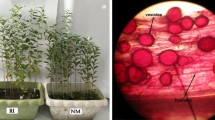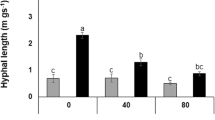Abstract
A field experiment was conducted to examine the effect of the arbuscular mycorrhizal fungus Glomus macrocarpum and salinity on growth of Sesbania aegyptiaca and S. grandiflora. In the salt-stressed soil, mycorrhizal root colonisation and sporulation was significantly higher in AM-inoculated than in uninoculated plants. Mycorrhizal seedlings had significantly higher root and shoot dry biomass production than non-mycorrhizal seedlings grown in saline soil. The content of chlorophyll was greater in the leaves of mycorrhiza-inoculated as compared to uninoculated seedlings. The number of nodules was significantly higher in mycorrhizal than non-mycorrhizal plants. Mycorrhizal seedling tissue had significantly increased concentrations of P, N and Mg but lower Na concentration than non-mycorrhizal seedlings. Under salinity stress conditions both Sesbania sp. showed a high degree of dependence on mycorrhizae, increasing with the age of the plants. The reduction in Na uptake together with a concomitant increase in P, N and Mg absorption and high chlorophyll content in mycorrhizal plants may be important salt-alleviating mechanisms for plants growing in saline soil.




Similar content being viewed by others
References
Adams F, Burmester C, Hue NV, Long FL (1980) A comparison of column-displacement and centrifuge method for obtaining soil solutions. Soil Sci Soc Am J 44:733–735
Alam SM (1994) Nutrient uptake by plant under stress conditions. In: Pessakakli M (ed) Handbook of plant stress. Dekker, New York, pp 227–246
Aliasgharzadeh N, Rastin NS, Towfighi H, Alizadeh A (2001) Occurrence of arbuscular mycorrhizal fungi in saline soils of the Tabriz plain of Iran in relation to some physical and chemical properties of soil. Mycorrhiza 11:119–122
Al-Karaki GN (2000) Growth of mycorrhizal tomato and mineral acquisition under salt stress. Mycorrhiza 10:51–54
Al-Karaki GN, Clark RB (1998) Growth, mineral acquisition and water use by mycorrhizal wheat grown under water stress. J Plant Nutr 21:263–276
Al-Karaki GN, Hammad R, Rusan M (2001) Response of two cultivars differing in salt tolerance to inoculation with mycorrhizal fungi under salt stress. Mycorrhiza 11:43–47
Allen SE (1989) Chemical analysis of ecological materials, 2nd edn. Blackwell, Oxford
Allen EB, Cunningham GL (1983) Effects of vesicular arbuscular mycorrhizae on Distichlis spicata under three salinity levels. New Phytol 93:227–236
Apse MP, Dharon GS, Snedden WA, Bumerold E (1999) Salt tolerance conferred by overexpression of a vacuolar Na+/H+ antiport in Arabidopsis. Science 285:1256–1258
Arnon DJ (1949) Copper enzyme in isolated chloroplasts polyphenol oxidase in Beta vulgaris. Plant Physiol 24:1–15
Barea JM, Azcon R, Azcon-Aguilar C (1992) Vesicular-arbuscular mycorrhizal fungi in nitrogen-fixing systems. In: Norris JR, Read D, Varma A (eds) Methods in microbiology: technology for the study of mycorrhizae, vol 24. Academic Press, London, pp 391–416
Bethlenfalway CJ (1992) Vesicular-arbuscular mycorrhizal fungi in nitrogen fixing legumes: problems and prospects. In: Norris JR, Read D, Varma A (eds) Methods in microbiology: technology for the study of mycorrhizae, vol 24. Academic Press, London, pp 375–389
Cantrell IC, Linderman RG (2001) Preinoculation of lettuce and onion with VA mycorrhizal fungi reduces deleterious effects of soil salinity. Plant Soil 233:269–281
Copeman RH, Martin CA, Stutz JC (1996) Tomato growth in response to salinity and mycorrhizal fungi from saline and nonsaline soils. Hortic Sci 31:341–344
Dixon RK, Garg VK, Rao MV (1993) Inoculation of Leucaena and prosopis seedlings with Glomus and Rhizobium species in saline soil: rhizosphere relations and seedlings growth. Arid Soil Res Rehabil 7:133–144
Dixon RK, Mukerji KG, Chamola BP, Kaushik A (1997) Vesicular arbuscular mycorrhizal symbiosis in relationship to forestation in arid lands. Ann For 5:1–9
Duke ER, Johnson CR, Koch KE (1986) Accumulation of phosphorus, dry matter and betaine during NaCl stress of split-root citrus seedlings colonised with vesicular-arbuscular mycorrhizal fungi on zero, one or two halves. New Phytol 104:583–590
Founoune H, Duponnois R, Ba AM, El Bouami F (2002) Influence of the dual arbuscular endomycorrhizal/ectomycorrhizal symbiosis on the growth of Acacia holosericea (A. Cunn. ex G. Don) in glasshouse conditions. Ann For Sci 59:93–98
Gerdemann JW, Nicolson TH (1963) Spores of mycorrhizal Endogone species extracted from soil by wet sieving and decanting. Trans Br Mycol Soc 46:235–244
Giovannetti M, Mosse B (1980) An evaluation of techniques for measuring VA mycorrhizal infections in roots. New Phytol 84:489–500
Giri B, Kapoor R, Mukerji KG (2002) VA mycorrhizal techniques/VAM technology in establishment of plants under salinity stress conditions. In: Mukerji KG, Manorachari C, Singh J (eds) Techniques in mycorrhizal studies. Kluwer, Dordrecht, pp 313–327
Giri B, Kapoor R, Mukerji KG (2003) Influence of arbuscular mycorrhizal fungi and salinity on growth, biomass, and mineral nutrition of Acacia auriculiformis. Biol Fertil Soils 38:170–175
Grattan SR, Grieve CM (1999) Salinity-mineral nutrient relations in horticultural crops. Sci Hortic 78:127–157
Hamdy A (1990) Management practices under saline water irrigation. Acta Hortic 278:745–754
Hanway JJ, Heidel H (1952) Soil analysis methods as used in Iowa state college soil testing laboratory. Iowa Agric 57:1–31
Hartmond U, Schaesberg NV, Graham JH, Syverten JP (1987) Salinity and flooding stress effects on mycorrhizal and non-mycorrhizal citrus rootstock seedlings. Plant Soil 104:37–43
Hiscox JD, Isrealstan CP (1979) A method for extraction of chlorophyll from leaf tissues without maceration. Can J Bot 57:1334–1337
Juniper S, Abbott L (1993) Vesicular arbuscular mycorrhizas and soil salinity. Mycorrhiza 4:45–57
Kapoor R, Giri B, Mukerji KG (2002) Mycorrhization of coriander (Coriandrum sativum L.) to enhance the concentration and quality of essential oil. J Sci Food Agric 82:339–342
Koske RE, Gemma JN (1989) A modified procedure for staining roots to detect VA mycorrhizas. Mycol Res 92:486–505
Marschner H (1995) Mineral nutrition of higher plants, 2nd edn. Academic Press, New York
Munns R (1993) Physiological responses limiting plant growth in saline soils: some dogmas and hypotheses. Plant Cell Environ 16:15–24
Ojala JC, Jarrell, WM, Menge JA, Johnson ELV (1983) Influence of mycorrhizal fungi on the mineral nutrition and yield of onion in saline soil. Agron J 75:255–259
Olsen SR, Cole CV, Watanabe FS, Dean LA (1954) Estimation of available phosphorus in soils by extraction with sodium bicarbonate. Circ US Dep Agric 939
Orlovick DA, Ashford AE (1993) Polyphosphate granules are artifact of specimen preparation in the ectomycorrhizal fungus Pisolithus tinctorius. Protoplasma 173:91–102
Pfeiffer CM, Bloss HE (1988) Growth and nutrition of guayule (Parthenium argentatum) in a saline soil as influenced by vesicular-arbuscular mycorrhiza and phosphorus fertilization. New Phytol 108:315–321
Plaut Z, Grieve CM (1988) Photosynthesis of salt stressed maize as influenced by Ca:Na ratios in the nutrient solution. Plant Soil 105:283–286
Plenchette C, Fortin JA, Furlan V (1983) Growth responses of seasonal plant species to mycorrhizae in a soil of moderate P-fertility. I Mycorrhizal dependency under field conditions. Plant Soil 70:199–209
Pond EC, Menge JA, Jarrell WM (1984) Improved growth of tomato in salinized soil by vesicular arbuscular mycorrhizal fungi collected from saline sites. Mycologia 76:74–84
Poss IA, Pond EC, Menge JA, Jarrell WM (1985) Effect of salinity on mycorrhizal onion and tomato in soil with and without additional phosphate. Plant Soil 88:307–319
Rinaldelli E, Mancuso S (1996) Response of young mycorrhizal and non-mycorrhizal plants of olive tree (Olea europaea L.) to saline conditions. I. Short-term electrophysiological and long-term vegetative salt effects. Adv Hortic Sci 10:126–134
Ruiz-Lozano JM, Azcon R (2000) Symbiotic efficiency and infectivity of an autochthonous arbuscular mycorrhizal Glomus Sp. from saline soils and Glomus deserticola under salinity. Mycorrhiza 10:137–143
Sharma MP, Gour A, Bhatia NP, Adholeya A (1996) Growth responses and dependence of Acacia nilotica var. cupriformis on the indigenous arbuscular mycorrhizal consortium of a marginal wasteland soil. Mycorrhiza 6:169–177
Sharma MP, Bhatia NP, Adholeya A (2001) Mycorrhizal dependency and growth responses of Acacia nilotica and Albizzia lebbeck to inoculation by indigenous AM fungi as influenced by available soil P levels in a semi-arid Alfisol wasteland. New For 21:89–104
Singh D, Chhonkar PK, Pandey RN (2001) Soil plant water analysis: a methods manual. Division of Soil Science and Agriculture Chemistry, Indian Institute of Agricultural Research, New Delhi, India
Acknowledgements
The authors thank Dr. Abhinav K. Goswami (Department of Statistics, University of Delhi) for statistical analysis and Dr. Rani Gupta and Inderjit Singh for critical suggestions. The technical assistance of Ms. Meenakshi Sharma is acknowledged. The senior author is thankful to CSIR for financial support.
Author information
Authors and Affiliations
Corresponding author
Rights and permissions
About this article
Cite this article
Giri, B., Mukerji, K.G. Mycorrhizal inoculant alleviates salt stress in Sesbania aegyptiaca and Sesbania grandiflora under field conditions: evidence for reduced sodium and improved magnesium uptake. Mycorrhiza 14, 307–312 (2004). https://doi.org/10.1007/s00572-003-0274-1
Received:
Accepted:
Published:
Issue Date:
DOI: https://doi.org/10.1007/s00572-003-0274-1




